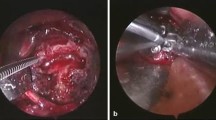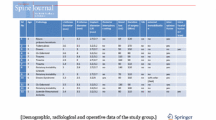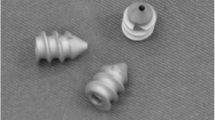Abstract
Introduction
We evaluate the feasibility, safety, and efficacy of atlantoaxial screw and rod fixation for revision operations in the treatment of re-dislocation after atlantoaxial operations in children.
Methods
Eight consecutive children with atlantoaxial instability required a revision operation due to atlantoaxial re-dislocation caused by the failure of the initial posterior wire fixation. The children were 5–11 years of age with an average age of 8.5 years. The posterior atlantoaxial screw and rod fixation and fusion operation was then performed. Autograft bones harvested from rib (in 3 patients), local bone (2 patients), and the iliac crest bone (3 patients) were used.
Results
There were no complications such as vertebral artery or spinal cord injury during the operations or loosening or fracture of the fixations after the operations. Stability and reduction of the atlantoaxial segments were achieved in all patients postoperatively. Follow-up time was 24–55 months, with an average of 35 months. All patients achieved solid osseous fusion demonstrated on plain radiographs or CT scanning. Atlantoaxial screw and rod fixation is feasible in children and may be considered for use during the initial operation in the treatment of atlantoaxial dislocation in children to minimize the need for a revision operation.
Conclusion
If a revision operation is required, atlantoaxial screw–rod fixation is a safe and effective method. Because the anatomical structure is complicated in revision operation patients, CAD-RP technology could guide the the procedures of exposure and screw placement.





Similar content being viewed by others
References
Magerl F, Seemann PS (1987) Stable posterior fusion of the atlas and axis by transarticular screw fixation. In: Kehr P, Weidner A (eds) Cervical Spine, vol 1. Springer, Strassbourg, pp 322–327
Henriques T, Cunningham BW, Olerud C, Shimamoto N, Lee GA, Larsson S, McAfee PA (2000) Biomechanical comparison of five different atlantoaxial posterior fixation techniques. Spine 25(22):2877–2883
Jeanneret B, Magerl F (1992) Primary posterior fusion C1/2 in odontoid fractures: indications, technique, and results of transarticular screw fixation. J Spinal Disord 5(4):464–475
Haid RW Jr (2001) C1-C2 transarticular screw fixation: technical aspects. Neurosurgery 49(1):71–74
Wright NM, Lauryssen C (1998) Vertebral artery injury in C1-2 transarticular screw fixation: results of a survey of the AANS/CNS section on disorders of the spine and peripheral nerves. American Association of Neurological Surgeons/Congress of Neurological Surgeons. J Neurosurg 88(4):634–640
Grob D, Jeanneret B, Aebi M, Markwalder TM (1991) Atlanto-axial fusion with transarticular screw fixation. J Bone Joint Surg Br 73(6):972–976
Dickman CA, Sonntag VK (1998) Posterior C1-C2 transarticular screw fixation for atlantoaxial arthrodesis. Neurosurgery 43(2):275–280 (discussion 280–1)
Madawi AA, Casey AT, Solanki GA, Tuite G, Veres R, Crockard HA (1997) Radiological and anatomical evaluation of the atlantoaxial transarticular screw fixation technique. J Neurosurg 86(6):961–968
Paramore CG, Dickman CA, Sonntag VK (1996) The anatomical suitability of the C1-2 complex for transarticular screw fixation. J Neurosurg 85(2):221–224
Brockmeyer D, Apfelbaum R, Tippets R, Walker M, Carey L (1995) Pediatric cervical spine instrumentation using screw fixation. Pediatr Neurosurg 22(3):147–157
Gluf WM, Brockmeyer DL (2005) Atlantoaxial transarticular screw fixation: a review of surgical indications, fusion rate, complications, and lessons learned in 67 pediatric patients. J Neurosurg Spine 2(2):164–169
Reilly CW, Choit RL (2006) Transarticular screws in the management of C1-C2 instability in children. J Pediatr Orthop 26(5):582–588
Brockmeyer DL, York JE, Apfelbaum RI (2000) Anatomical suitability of C1-2 transarticular screw placement in pediatric patients. J Neurosurg 92(1 Suppl):7–11
Goel A, Laheri V (1994) Plate and screw fixation for atlanto-axial subluxation. Acta Neurochir (Wien) 129(1–2):47–53
Harms J, Melcher RP (2001) Posterior C1-C2 fusion with polyaxial screw and rod fixation. Spine 26:2467–2471
Ma XY, Yin QS, Wu ZH, Xia H, Liu JF, Zhong SZ (2005) Anatomic considerations for the pedicle screw placement in the first cervical vertebra. Spine 30(13):1519–1523
Tan M, Wang H, Wang Y, Zhang G, Yi P, Li Z, Wei H, Yang F (2003) Morphometric evaluation of screw fixation in atlas via posterior arch and lateral mass. Spine 28(5):888–895
Resnick DK, Lapsiwala S, Trost GR (2002) Anatomic suitability of the C1-C2 complex for pedicle screw fixation. Spine 27(14):1494–1498
Ebraheim N, Rollins JR Jr, Xu R, Jackson WT (1996) Anatomic consideration of C2 pedicle screw placement. Spine 21(6):691–695
Xu R, Nadaud MC, Ebraheim NA, Yeasting RA (1995) Morphology of the second cervical vertebra and the posterior projection of the C2 pedicle axis. Spine 20(3):259–263
Wright NM (2004) Posterior C2 fixation using bilateral crossing C2 laminar screws: case series and technical note. J Spinal Disord Tech 17(2):158–162
Goel A, Desai KI, Muzumdar DP (2002) Atlantoaxial fixation using plate and screw method: a report of 160 treated patients. Neurosurgery 51(6):1351–1357
Chamoun RB, Whitehead WE, Curry DJ, Luerssen TG, Jea A (2009) Computed tomography morphometric analysis for C-1 lateral mass screw placement in children. J Neurosurg Pediatr 3(1):20–23
Haque A, Price AV, Sklar FH, Swift DM, Weprin BE, Sacco DJ (2009) Screw fixation of the upper cervical spine in the pediatric population. J Neurosurg Pediatr 3(6):529–533
Desai R, Stevenson CB, Crawford AH, Durrani AA, Mangano FT (2010) C-1 lateral mass screw fixation in children with atlantoaxial instability: case series and technical report. J Spinal Disord Tech 23(7):474–479
Heuer GG, Hardesty DA, Bhowmick DA, Bailey R, Magge SN, Storm PB (2009) Treatment of pediatric atlantoaxial instability with traditional and modified Goel-Harms fusion constructs. Eur Spine J 18(6):884–892
Hedequist D, Proctor M (2009) Screw fixation to C2 in children: a case series and technical report. J Pediatr Orthop 29(1):21–25
Leonard JR, Wright NM (2006) Pediatric atlantoaxial fixation with bilateral, crossing C-2 translaminar screws. J Neurosurg 104(1):59–63
Jea A, Taylor MD, Dirks PB, Kulkarni AV, Rutka JT, Drake JM (2007) Incorporation of C-1 lateral mass screws in occipitocervical and atlantoaxial fusions for children 8 years of age or younger. Technical note. J Neurosurg 107(2 Suppl):178–183
Paiva WS, Amorim R, Bezerra DA, Masini M (2007) Aplication of the stereolithography technique in complex spine surgery. Arq Neuropsiquiatr 65(2B):443–445
Yang JC, Ma XY, Lin J, Wu ZH, Zhang K, Yin QS (2011) Personalised modified osteotomy using computer-aided design-rapid prototyping to correct thoracic deformities. Int Orthop 35(12):1827–1832
Bagaria V, Deshpande S, Rasalkar DD, Kuthe A, Paunipagar BK (2011) Use of rapid prototyping and three-dimensional reconstruction modeling in the management of complex fractures. Eur J Radiol 80(3):814–820
Gallie WE (1939) Fractures and dislocations of the cervical spine. Am J Surg 46:495–499
Brooks AL, Jenkins EB (1978) Atlanto-axial arthrodesis by the wedge compression method. J Bone Joint Surg Am 60(3):279–284
Jeanneret B, Magerl F, Ward EH, Ward JC (1991) Posterior stabilization of the cervical spine with hook plates. Spine 16(3 Suppl):S56–S63
Ma XY, Yin QS, Wu ZH, Xia H, Liu JF, Xiang M, Zhao WD, Zhong SZ (2009) C1 pedicle screws versus C1 lateral mass screws: comparisons of pullout strengths and biomechanical stabilities. Spine 34(4):371–377
Richter M, Schmidt R, Claes L, Puhl W, Wilke HJ (2002) Posterior atlantoaxial fixation biomechanical in vitro comparison of six different techniques. Spine 27(16):1724–1732
Melcher RP, Puttlitz CM, Kleinstueck FS, Lotz JC, Harms J, Bradford DS (2002) Biomechanical testing of posterior atlantoaxial fixation techniques. Spine 27(22):2435–2440
Acknowledgments
This work was supported by Fund of Medical Science Research of 12th Chinese Five-Year Plan (NO: BWS11C065).
Conflict of interest
None.
Author information
Authors and Affiliations
Corresponding author
Rights and permissions
About this article
Cite this article
Ma, X., Yin, Q., Xia, H. et al. The application of atlantoaxial screw and rod fixation in revision operations for postoperative re-dislocation in children. Arch Orthop Trauma Surg 135, 313–319 (2015). https://doi.org/10.1007/s00402-014-2150-1
Received:
Published:
Issue Date:
DOI: https://doi.org/10.1007/s00402-014-2150-1




